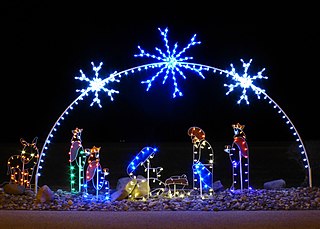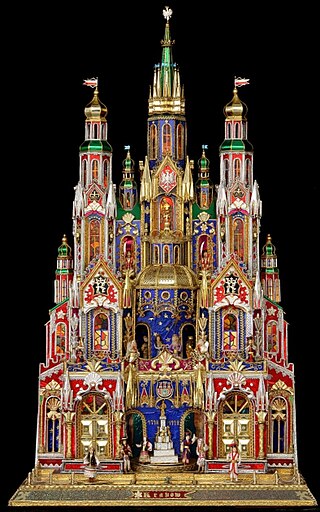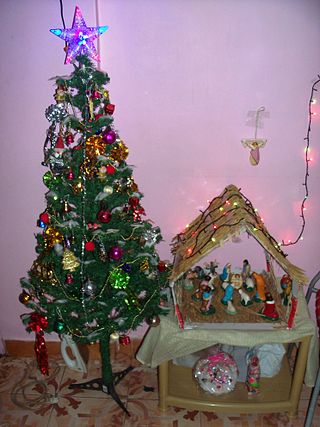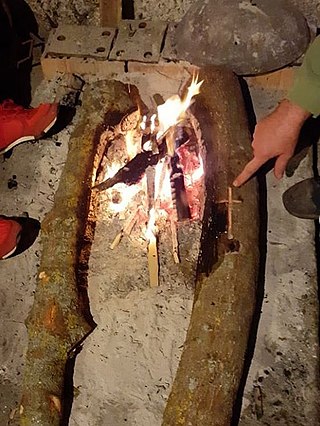
Christmas is an annual festival commemorating the birth of Jesus Christ, observed primarily on December 25 as a religious and cultural celebration among billions of people around the world. A feast central to the liturgical year in Christianity, it follows the season of Advent or the Nativity Fast, and initiates the season of Christmastide, which historically in the West lasts twelve days and culminates on Twelfth Night. Christmas Day is a public holiday in many countries, is celebrated religiously by a majority of Christians, as well as culturally by many non-Christians, and forms an integral part of the holiday season surrounding it.

Christmas in Poland is a major annual celebration, as in most countries of the Christian world. The observance of Christmas developed gradually over the centuries, beginning in ancient times; combining old Polish pagan customs with the religious ones introduced after the Christianization of Poland by the Catholic Church. Later influences include the mutual permeating of local traditions and various folk cultures. It is one of the most important religious holidays for Poles, who follow a somewhat strict traditional custom. Christmas trees are decorated and lit in family rooms on the day of Christmas Eve. Other trees are placed in most public areas and outside churches. Christmas in Poland is called "Boże Narodzenie", which translates to 'God's Birth'.

A Christmas tree is a decorated tree, usually an evergreen conifer, such as a spruce, pine or fir, or an artificial tree of similar appearance, associated with the celebration of Christmas.

Advent is a season observed in most Christian denominations as a time of expectant waiting and preparation for both the celebration of the Nativity of Christ at Christmas and the return of Christ at the Second Coming. Advent is the beginning of the liturgical year in Western Christianity. The name was adopted from Latin adventus "coming; arrival", translating Greek parousia from the New Testament, originally referring to the Second Coming.

A wreath is an assortment of flowers, leaves, fruits, twigs, or various materials that is constructed to form a ring shape.

The Chi Rho is one of the earliest forms of the Christogram, formed by superimposing the first two (capital) letters—chi and rho (ΧΡ)—of the Greek word ΧΡΙΣΤΟΣ (Christos) in such a way that the vertical stroke of the rho intersects the center of the chi.

The Advent wreath, or Advent crown, is a Christian tradition that symbolizes the passage of the four weeks of Advent in the liturgical calendar of the Western church. It is traditionally a Lutheran practice, although it has spread to many other Christian denominations.

Christmastide, also known as Christide, is a season of the liturgical year in most Christian churches.

An Advent calendar, from the German word Adventskalender, is used to count the days of Advent in anticipation of Christmas. Since the date of the First Sunday of Advent varies, falling between November 27 and December 3 inclusive, many reusable Advent calendars made of paper or wood begin on December 1. Others start from the First Sunday of Advent.

Christmas lights are lights often used for decoration in celebration of Christmas, often on display throughout the Christmas season including Advent and Christmastide. The custom goes back to when Christmas trees were decorated with candles, which symbolized Christ being the light of the world. The Christmas trees were brought by Christians into their homes in early modern Germany.

A tree-topper or treetopper is a decorative ornament placed on the top of a Christmas tree. Tree-toppers can take any form, though the most common include a star, angel, or fairy. Additional forms range from a paper rosette, ribbon bow, Father Christmas or Santa Claus, to a Christian cross, owl, white dove, spike, or sunburst.

A Christogram is a monogram or combination of letters that forms an abbreviation for the name of Jesus Christ, traditionally used as a religious symbol within the Christian Church.

A Christmas decoration is any of several types of ornamentation used at Christmastide and the greater holiday season. The traditional colors of Christmas are pine green (evergreen), snow white, and heart red. Gold and silver are also prevalent, as are other metallic colours. Typical images on Christmas decorations include Baby Jesus, Mother Mary, angels, Father Christmas, Santa Claus, and the star of Bethlehem. Advent wreaths, nativity scenes, illuminations, and Moravian stars are popular Christmas decorations.

Advent Sunday, also called the First Sunday of Advent or First Advent Sunday, among the Western Christian Churches, is the first day of the liturgical year and the start of the season of Advent.

Christian symbolism is the use of symbols, including archetypes, acts, artwork or events, by Christianity. It invests objects or actions with an inner meaning expressing Christian ideas.

The tradition of egg decoration in Slavic cultures originated in pagan times, and was transformed by the process of religious syncretism into the Christian Easter egg. Over time, many new techniques were added. Some versions of these decorated eggs have retained their pagan symbolism, while others have added Christian symbols and motifs.

Badnjak, refers to a log brought into the house and placed on the fire on the evening of Christmas Eve, a central tradition in Croatian Christmas celebration, much like a yule log in other European traditions. In Croatian, the name for Christmas Eve is derived from the term badnjak. The log is cut with great ceremony on Christmas Eve morning, which for Roman Catholic Croats is December 24. The cutting, preparation, bringing in, and laying on the fire are surrounded by elaborate religious rituals, with many regional variations. The log is kept burning throughout Christmas Day.

The German: Herrenhäuser Kirche in Hanover-Herrenhausen, Lower Saxony, Germany) is a church built in neo-Gothic style. Located close to the Herrenhausen Gardens, it belongs to the Lutheran congregation of the Herrenhausen-Leinhausen parish and is a listed historic building.

The hanging of the greens is a Western Christian ceremony in which many congregations and people adorn their churches, as well as other buildings, with Advent and Christmas decorations. This is done on or directly before the start of the Advent season, in preparation for Christmastide. The service involves the placement of evergreen vegetation in the parish. Items such as the evergreen wreath, in Christianity, carry the religious symbolism of everlasting life, a theological concept within that faith. As such, during the liturgy, "Biblical passages and other readings help explain the significance of the holly, the cedar, the Advent wreath, the Chrismon tree, and any other special decorations". Christmas trees are frequently erected during the hanging of the greens, although they are sometimes left bare until Christmas Eve.

Christmas traditions include a variety of customs, religious practices, rituals, and folklore associated with the celebration of Christmas. Many of these traditions vary by country or region, while others are practiced virtually identically worldwide.






















